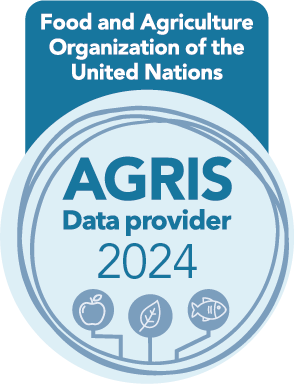Effect of Albendazole at different concentrations on fertilization and early cleavage in Tetrapygus niger “sea urchin”
DOI:
https://doi.org/10.17268/sci.agropecu.2013.03.11Keywords:
Albendazole, fertilization, early cleavage, Tetrapygus nigerAbstract
In this study we evaluated the effect of Albendazole at different concentrations and exposure times on the process of fertilization and early cleavage in Tetrapygus niger "sea urchin". Each experimental group consisted of 200 mL, of previously filtered seawater at pH 7.3 and temperature of 20 ± 2 °C, plus five drops of eggs and two drops of spermatozoa exposed to different concentrations of Albendazole 400 ppm, 800 ppm and 1200 ppm. Determining the effect of Albendazole was conducted by counting the number of cones of fertilization, as well as the number of cleaving embryos with normal and abnormal. The ANOVA and multiple comparison test Tukey averages showed significant differences between the treatments, namely that increasing the concentration of Albendazole fertilization rate decreases and increases the percentage of embryos with abnormal cleavage, so therefore concluded that the Albendazole at different concentrations and exposure times affects the process of fertilization and early cleavage in T, niger "sea urchin".References
Astudillo, D.; Rosas, J.; Velásquez, A.; Cabrera, T.; Maneiro, C. 2005. Crecimiento y supervivencia de larvas de Echinometra lucunter (Echinoidea: Echinometridae) alimentadas con las microalgas Chaetoceros gracilis e Isochrysis galbana. Rev. Biol. Trop. 53: 377-344.
Beltrán, R. 2000. Efectos de la piridina irradiada con Láser Ultravioleta (337nm) en la fecundación y segmentación temprana de Tetrapigus niger L. Trabajo de habilitación para promoción docente de profesor auxiliar a profesor asociado. Universidad Nacional de Trujillo, Perú.
De Robertis, E.; Hib, J.; Ponzio, R. 1997. Biología Celular y Molecular. 12ava edic. Buenos Aires, El Ateneo.
Doig, D. 1992. Aspectos celulares y moleculares de la fecundación in vitro de erizo de mar. Trabajo de capacitación para obtener el título de Biólogo, Universidad Nacional de Trujillo.
Donal, J.; Ecobichon, E. 1997. The Basis of Toxicity Testing. 2ª Edición- CRC Press, ISBN 0-8493-8554-7. Disponible en http://www,iqb,es/cbasicas/farma/ farma05/tox/tox01,htm.
Gilbert, F. 2003. Biología del desarrollo. Editorial panamericana. 7ma edición. Pág. 197-246.
Gómez, M.; Gómez, G. 2005. Desarrollo embrionario y larval de Lytechinus variegatus (echinoidea: toxopneustidae) en condiciones de laboratorio en la Isla de Margarita-Venezuela. Rev. Biol. Trop. 53: 313-318.
Karp, G. 1998. Biología Celular y Molecular. Edit McGraw-Hill Interamericana, México.
Larrea, N.; Torres, F.; Tello, M.; Gutiérrez, E. 2011. Efecto de la administración de albendazol en los niveles de hemoglobina entre ocho y doce años con enterobiosis intestinal. Revista Peruana de Epidemiología 15: 1-4.
Paniagua, R. 2003. Biología Celular 2° ed. Editorial Mc. Graw-Hill. Madrid – España.
Steel, R.; Torrie, J. 1993. Bioestadística: Principios y Procedimientos. 2da edición. Editorial Mc. Graw Hill S.A. México.
Torrelio, A.; Vino, L.; Mamani-Linares, W.; Loza, M. 2011. Determinación de la eficiencia antihemintica del Albendazol y Febendazol en Moniezia expanza (Rudolphi 1810) & Thysanosoma actinioides (Diensing 1834) (Castoda: Anoplocephalidae) en ovinos criollos infectados naturalmente en una estacia da la comunidad de Comanche, Provincia Pacajes Departamento de La Paz, Bolivia. Journal of the Selva Andina Research Society 2(1): 2 – 16.
Zamora, S.; Stotz, W. 1993. Ciclo reproductivo de Tetrapygus niger (Echinodermata: Echinoidea) en los localidades de la IV Región, Coquimbo, Chile. Revista Chilena de Historia Natural 66: 155-169.
Received: 08/08/13
Accepted: 30/08/13
Corresponding author: E-mail: gies20041@hotmail.com (G. Zavaleta)
Downloads
Published
How to Cite
Issue
Section
License
The authors who publish in this journal accept the following conditions:
a. The authors retain the copyright and assign to the magazine the right of the first publication, with the work registered with the Creative Commons attribution license, which allows third parties to use the published information whenever they mention the authorship of the work and the First publication in this journal.
b. Authors may make other independent and additional contractual arrangements for non-exclusive distribution of the version of the article published in this journal (eg, include it in an institutional repository or publish it in a book) as long as it clearly indicates that the work Was first published in this journal.
c. Authors are encouraged to publish their work on the Internet (for example, on institutional or personal pages) before and during the review and publication process, as it can lead to productive exchanges and a greater and faster dissemination of work Published (see The Effect of Open Access).




